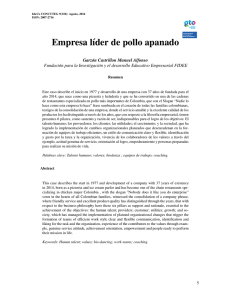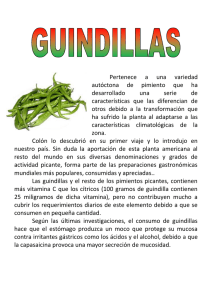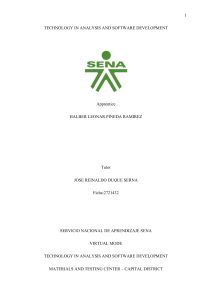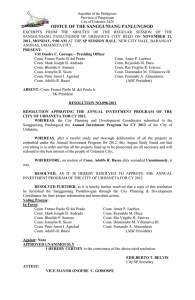Review/Reseña From Someone to Nothing and Back Again Brian L
Anuncio
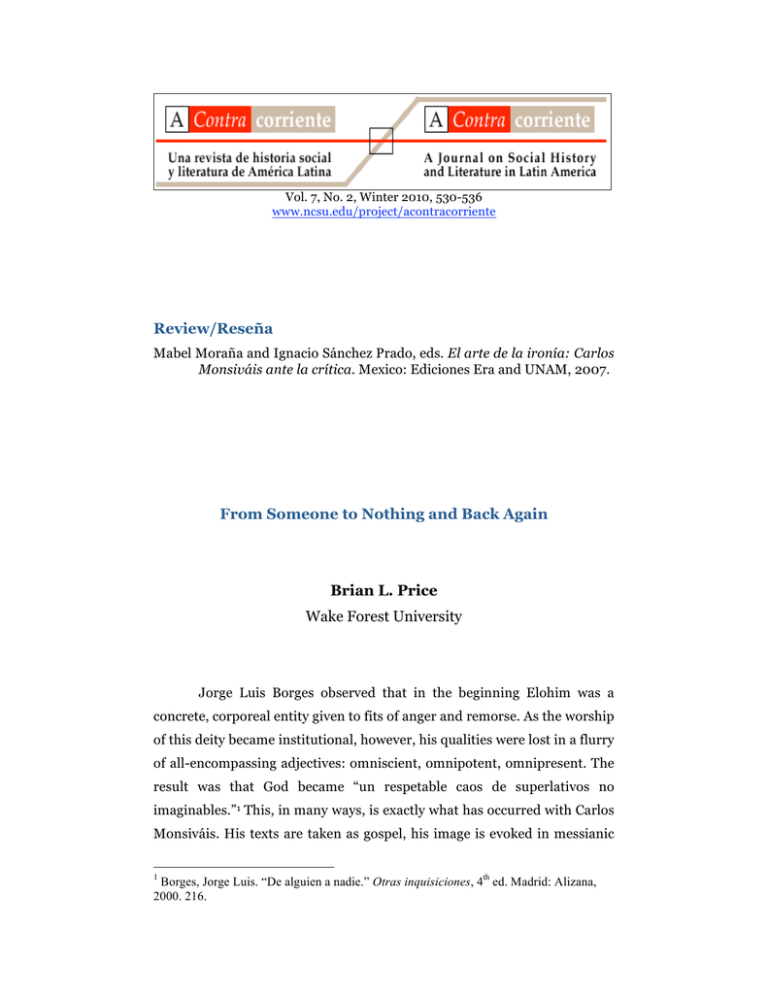
Vol. 7, No. 2, Winter 2010, 530-536 www.ncsu.edu/project/acontracorriente Review/Reseña Mabel Moraña and Ignacio Sánchez Prado, eds. El arte de la ironía: Carlos Monsiváis ante la crítica. Mexico: Ediciones Era and UNAM, 2007. From Someone to Nothing and Back Again Brian L. Price Wake Forest University Jorge Luis Borges observed that in the beginning Elohim was a concrete, corporeal entity given to fits of anger and remorse. As the worship of this deity became institutional, however, his qualities were lost in a flurry of all-encompassing adjectives: omniscient, omnipotent, omnipresent. The result was that God became “un respetable caos de superlativos no imaginables.”1 This, in many ways, is exactly what has occurred with Carlos Monsiváis. His texts are taken as gospel, his image is evoked in messianic 1 Borges, Jorge Luis. “De alguien a nadie.” Otras inquisiciones, 4th ed. Madrid: Alizana, 2000. 216. Price 531 ways, and his name is referenced as an unimpeachable authority. He is Mexico’s cultural lawgiver, his words etched in stone tablets by the almighty hand of the divine. As Christopher Domínguez Michael puts it, “La omnipresencia de Monsiváis en la vida política, cultural y literaria de México durante buena parte del último siglo lo ha convertido, dada la extrema originalidad de una figura tan poderosa como esquiva, en un gran desconocido.”2 Monsiváis, it would appear, has transcended the boundaries of mortality and taken his seat among the immortals. Reverenced by all as the chief deity of the crónica, Monsiváis has evaded criticism. Or, maybe more rightly, critics have avoided Monsiváis. This is not to say that no articles have been written nor papers presented; some have been quite insightful, but many have been docile, preferring to lavish his works and his person with praise without entering into the intellectual debate that his chronicles most certainly deserve. After nearly fifty years of intellectual production, it seems odd—almost unthinkable— that the first substantial book dedicated to his work appeared in 2001. Linda Egan’s Carlos Monsiváis: Culture and Chronicle in Mexico was a pioneering work because it dared to address the author’s work, and not simply his deified stature. Her book is a worthwhile read for anyone interested in deepening his/her knowledge about the chronicle genre and Monsiváis’s work. But despite her insightful analysis, it is only one book by one author, and serves as more of a starting point than as a final destination. What has been consistently missing in Monsiváis studies is a consolidated community of critics dedicated to teasing out the difficulties and implications of this author’s work. El arte de la ironía: Carlos Monsiváis ante la crítica, coedited by Mabel Moraña and Ignacio M. Sánchez Prado, accepts this challenge. And this reverential attitude is exactly what the editors have attempted to avoid: “el volumen asume de lleno la importancia de Carlos Monsiváis en los debates actuales sobre la cultura, al plantear una perspectiva crítica sobre su obra y no una simple celebración de ella, evitando lo que Monsiváis ha criticado siempre: la apresurada monumentalización que congela la obra 2 Domínguez Michael, Christopher. Diccionario crítico de la literatura mexicana (1955-2005). Mexico: FCE, 2007, 330. From Someone to Nothing and Back Again 532 cuando la eleva acríticamente al pedestal de lo canónico” (16-17). This important new volume reigns in deferential enthusiasm; subjects the author’s work to conscientious, intelligent, and thorough analysis; and offers Monsiváis up as “un paradigma insoslayable para todo aquel que desee penetrar la racionalidad contaminada y exultante de la postmodernidad, los vericuetos paradójicos de la cultura popular, el entramado de los social y lo político, dentro y también más allá de los límites restrictivos de las instituciones nacionales” (9). The book belongs to the “Escritores ante la crítica” series, a distinguished collection of edited volumes published by the Universidad Nacional Autónoma de México (UNAM) and Ediciones Era. Other books in the series have studied authors such as Juan Rulfo, Augusto Monterroso, José Revueltas, Juan García Ponce, and José Emilio Pacheco. These authors have, in their own right, made their mark on Mexican letters and have amassed their own critical followings. Most, however, are likely to remain in their national canon. Monsiváis, like Rulfo, has gained that level of general recognition that transcends national borders and demands broad critical appreciation. El arte de la ironía is divided into five sections, each with a title that playfully appropriates one of Monsiváis’s own titles. The first, “Monsiváis: entrada libre,” offers readers a general overview of his place within Mexico’s literary canon, taking into account basic concerns of chronicle theory. The editors’ avowed purpose is to initiate this discussion “a base de textos que abren líneas generales de discusión y proporcionan un mapa de ella [su obra] y su ubicación en los estudios de la cultura” (14). The second, “Ritualizar el caos: cultura y modernidad en el México contemporáneo”, studies Monsiváis at the crossroads culture and modernity, privileging readings that underline the author’s role as mediator between center and periphery. All of these analyses focus on topics specifically germane to Mexico’s cultural climate: national identity and politics, immigration, gay counterculture, and popular culture. In the third part, “Los estudios de la cultura y sus aires de familia,” critics place Monsiváis’s work within a broader context of cultural studies that surpasses boundaries of nationality, looking specifically at Monsiváis’s contributions to historiography, film, literature, and the study of violence. The fourth section, “Monsiváis y el Price 533 campo intelectual: escenas de poder y liviandad,” expands upon the development of the author’s ideology, reads him within the context of Mexican politics, and interprets his work as a continuation of Mexican liberalism. The concluding section, “Coda: testimonios y comentarios”, incorporates reflections from four important Mexican writers: Sergio Pitol, Margo Glantz, Adolfo Castañón, and Juan Villoro. El arte de la ironía also directs readers to a vast catalog of Monsiváis texts and criticism. The volume closes with a 62-page bibliography in small type to Monsiváis’s work; thirty-three of these pages list Monsiváis’s writings while the remaining 29 attest to the interest he has generated among literary critics. Gathering top-notch scholars who wheedle out the sticky points of language, unmask the subtleties of irony, and lay out for readers the scope of an author’s cultural and social significance is the key to any successful volume. With El arte de la ironía, Moraña and Sánchez Prado have done just this. A cursory look at the table of contents reveals a number of wellknown Monsiváis scholars: Linda Egan, María Eugenia Mudrovcic, Sebastian Faber, Evodio Escalante, Norma Klahn, Jean Franco, José Ramón Ruisánchez, and Christopher Domínguez Michael, among others. It would be difficult to offer a summary of each author’s main argument; overall, the articles are well-written, expansive, and worth reading for their individual merit, above and beyond the additional meaning they acquire in relation to their surrounding texts. That said, a number of these studies merit special attention: Moraña’s article traces a thorough genealogy of the chronicle in Mexico from the Conquest through Lizardi, Altamirano, and Novo to today, demonstrating aptly how Monsiváis dialogues with each author as well as with the contemporary thought of Michel de Certeau, Raymond Williams, and Félix Guattari. Kraniauskas’ contribution is an intelligent introduction to the chronicle as a genre. Egan’s reading of Monsiváis’s biographical work on Salvador Novo as poetic and sexual pioneer demonstrates keen scholarship, insightful cultural commentary, and attractive style. Ruisánchez analyzes the author’s critique of national historiographic texts from within and demonstrates how Monsiváis “tiene que sacrificar algunas de las prácticas que privilegia en la crónica” in order to “construir una explicación del presente diversa a la del discurso From Someone to Nothing and Back Again 534 hegemónico oficial para subrayar la posibilidad de crear tales discursos” (254). In Sánchez Prado’s article, the critic identifies Monsiváis’s early education within Mexico’s leftist camps but asserts that “la ética política y literaria de Monsiváis es más cercana a su lectura del liberalismo que a la tradición de esta izquierda” (303). Faber’s work focuses on the relationship between Monsiváis and Ortega y Gasset. For those interested in film, D’Lugo’s expansive work on Monsiváis’s criticism merits a close reading. This summarization, brief though it may be, attests to the breadth of topics that appears in the volume, and rightly so. Because Monsiváis’s work is so wide-ranging, it is necessary to approach him from a number of angles. To this end the editors assert that the book “no intenta prescribir o privilegiar una sola manera de aproximarse a Carlos Monsiváis. Más bien se ha tratado de convocar y de exponer una diversidad de discursos e interpretaciones que, a veces, llegan incluso a estar en abierta oposición” (16). This expansiveness calls for the development of a theoretical framework that accounts for the hybrid nature of his preferred genre and the extent of his interests. But, instead of allowing the volume to become a monstrous conglomeration of theory buzzwords and quotes grafted from critical superstars, Moraña and Sánchez Prado balance broad theoretical musings and close, detailed readings. Moraña, Sánchez Prado, and Gollnick, for example, lay out frameworks that allow for in-depth readings of Monsiváis’s work. Pons, Egan, Mudrovcic, and Franco, on the other hand, eschew elaborate theory, preferring to dive deeply into their selected texts. Both styles of writing find their place in this volume and do so in the correct dosage. The volume is bound together by a series of currents that groups of authors develop independent of the structural cohesion created by the editors’ grouping. One of the most prominent themes is the tension between periphery and center. Originally positioned as a peripheral author (being both protestant and gay), writing within a peripheral genre (the chronicle), Monsiváis is seen in the work of championing the disenfranchised, the impoverished, the indigenous, and the homosexual. Thus, speaking of geographic marginality and referring to the aftermath of the earthquake that devastated Mexico City in 1985, Norma Klahn writes Price 535 that “Monsiváis va re-articulando su crítica al centro hegemónico enfocándose en los espacios fuera de la ciudad, logrando así un productivo contrapunteo” (177). Villoro detects a similar distance from the center when he writes that Monsiváis, like Ismael from Moby Dick, “sobrevive al naufragio para contar la historia” from without, from the margins. On the other hand, Domínguez Michael observes that Monsiváis may have moved too much from the periphery, drawn too close to the center, or become too much of a point of reference: “Con los movimientos marginales que Monsiváis ha contribuido a a poner en el centro, él mismo ocupa el espacio axial de un personaje que con el tiempo va cobrando una dimension que obliga a repetir su nombre una y otra vez” (284). It is, perhaps, Monsiváis’s move from periphery to center that has caused so many problems for his readers. As a marginal intellectual that has been incorporated into the center of Mexican cultural and political life, Monsiváis takes advantage of his distant proximity and exists both within and without a cultural context in order to render it in all of its strangeness from divergent perspectives, being both etic (the analytical outside view) and emic (the privileged native take). While it is a common misconception that the emic tends to be biased and erroneous while the etic is objective and factual, both views provide insights into a society’s structure and development. The contributors to El arte de la ironía recognize this dual vision and disentangle its cultural importance, especially in Monsiváis work at dismantling “los discursos del poder que han operado a lo largo del siglo XX, dentro y fuera de México” (17). To conclude, it is worth noting that the fear associated with looking too closely at the divine derives from the potential to discover blemishes that might diminish faith. Deities are protectively shrouded in mystical, allencompassing adjectives making them more malleable to our own needs, and therefore we tend to overlook that which we worship. And while careful examination reveals imperfections, it also offers us more understanding and the opportunity to draw nearer. In El arte de la ironía, there is a concerted effort to restore those palpable points of humanity that make Monsiváis one of Mexico’s most entertaining, challenging, and thoughtprovoking reads. The volume presents Monsiváis as an author who is From Someone to Nothing and Back Again 536 inextricably linked to a landscape, a time, a set of ideas, and a commitment. It is a healthy portrait of this intellectual, and one that allows for a more satisfying appreciation for the relevance of his work.



